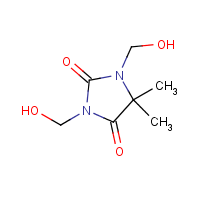DMDM hydantoin
Agent Name
DMDM hydantoin
Alternative Name
1,3-Dimethylol-5,5-dimethyl hydantoin
CAS Number
6440-58-0
Formula
C7-H12-N2-O4
Major Category
Other Uses

Synonyms
1,3-Dimethylol-5,5-dimethyl hydantoin; 1,3-Bis(hydroxymethyl)-5,5-dimethyl-2,4-imidazolidinedione; 1,3-Bis(hydroxymethyl)-5,5-dimethylhydantoin; 1,3-Di(hydroxymethyl)-5,5-dimethylhydantoin; 1,3-Dimethylol-5,5-dimethylhydantoin; DMDM hydantoin; Dantoin dmdmh 55; Dantoin-DMDMH; Dimethylol-5,5-dimethylhydantoin; DMDMH; DMDMH 55; Glycoserve-DMDMH; Glydant; 1,3-Bis(hydroxymethyl)-5,5-dimethylimidazolidine-2,4-dione; 2,4-Imidazolidinedione, 1,3-bis(hydroxymethyl)-5,5-dimethyl-; Hydantoin, 1,3-bis(hydroxymethyl)-5,5-dimethyl-; [ChemIDplus]
Category
Biocides/Disinfectants
Sources/Uses
Used as a biocide in cosmetics with 0.6% the maximum allowable concentration in the EU; [Kanerva, p. 398, 407] Used as an antimicrobial pesticide in cleaning products, adhesives, air fresheners, caulks, hydraulic fluids, inks, metal working cutting fluids, paints, stains, coatings, paper and paperboard coatings, polishes, synthetic polymers, sealants, starch solutions, resin emulsions, textiles, and wax; [Reference #1]
Comments
A formaldehyde releaser used in cosmetics; It can cause allergic contact dermatitis; "Rinse off products in general will have a low risk of causing allergic contact dermatitis." [Kanerva, p. 398-404] Reports of positive results for skin sensitization patch testing; [HSDB] A formaldehyde releasing agent present in combination with MDM hydantoin (CAS# 116-25-6) in the commercial product 2,4 Imidazolidinedione; Likely hydrolyzes/degrades to 5,5-dimethylhydantoin (DMH); [Reference #1] See "5,5-Dimethylhydantoin" and "Formaldehyde."
Biomedical References
Exposure Assessment
Vapor Pressure
9E-08 mm Hg
Explanatory Notes
VP from HSDB;
Adverse Effects
Skin Sensitizer
Yes
Diseases, Processes, and Activities Linked to This Agent
Diseases
Occupational diseases associated with exposure to this agent:
Processes
Industrial Processes with risk of exposure: